Ningxia in Pictures:
Featuring Hui People
and the Ningxia Red Wolfberry
Ningxia is an autonomous region in north-central China, just under Inner Mongolia. In China, an "autonomous region" is, roughly speaking, a province that is too undeveloped or underpopulated to be called a province. On this page you will see public domain photos of this economically backward but culturally interesting area.
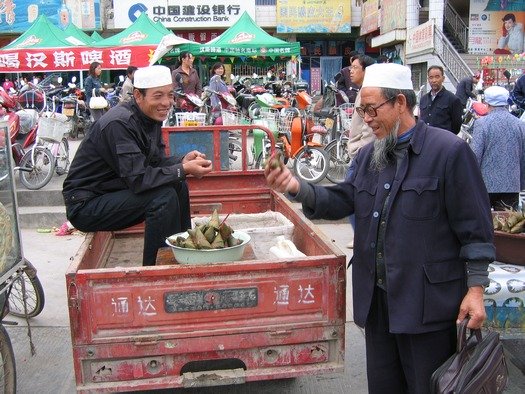
Roughly one third of the six million residents are of the Hui minority group, which follows Islamic practices. The two men in the photo above are Hui, as distinguished by their hats. The location above is Guyuan, the southernmost of Ningxia's five prefecture cities.
There are Hui people all over China, a total of about 10 million. Around 20% of them live in Ningxia and chances are that more would be there if better economic opportunities elsewhere didn't draw them away. Although economic development projects have resulted in 40% economic growth in some isolated pockets of Ningxia, it is still quite poor, ranking third-last among China's provinces and autonomous regions.
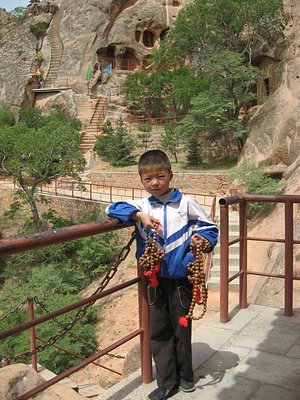
Islam is not the only religion in the area though. Like the rest of
China, the Ningxia area has had much Buddhist influence in its history.
On the left is a boy selling prayer beads at the Xumi Shan Buddhist
grottoes, which are about 50 km north of Guyuan. More than 130 caves
were carved out of the sandstone cliffs starting 1400 years ago. The
interesting thing is that the caves include over 300 Buddha statues
carved in place. One of the Buddhas is 19m tall!
Because tourists seldom go to Ningxia, few foreigners see this interesting and well-worthwhile cultural site.
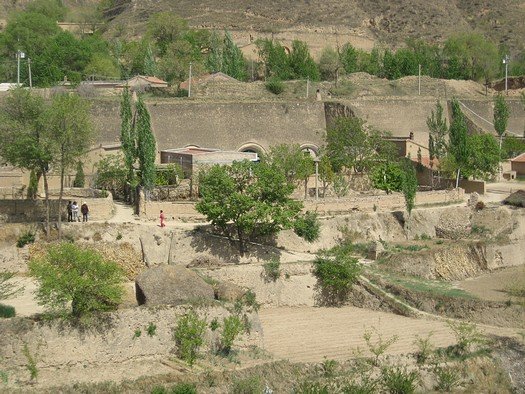
Above you see again sparse vegetation and barren hillsides, this time in Penyang. Given hillsides like this and lack of wood for building material, it is not too surprising that some families that still live in homes cut from the rock. One of my friends who teaches at Ningxia University told me that one of her students lives in such a cave home.
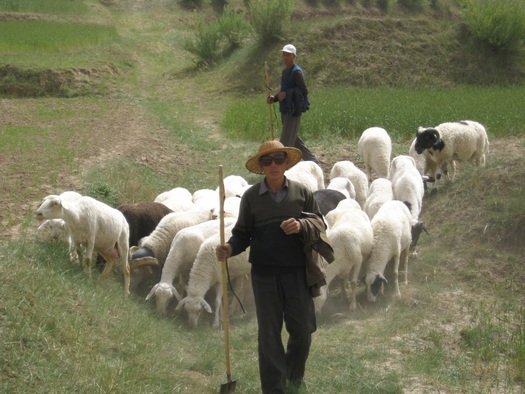
Almost anywhere in China you can find sheep and they often do OK in semi-barren areas like you see here. Above you see a couple of shepherds near Guyuan.
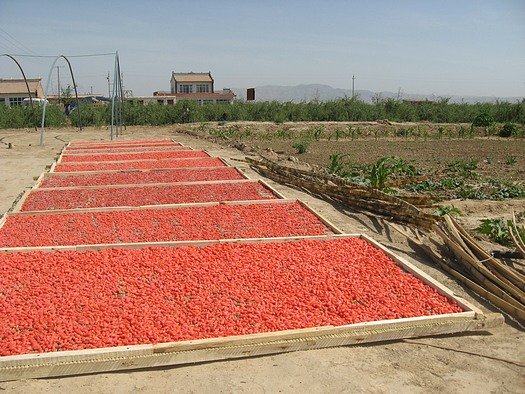
A significant part of the Ningxia economy revolves around the red
wolfberry. Here you see trays of them drying in the sun. A Chinese
medical book from 2200 years ago recommends wolfberries, also known as
"goji" berries, for strengthening vital organs. The Chinese national
Xinhua news agency reports that of the 80 varieties of wolfberry, the
type with the best medicinal qualities come from Ningxia.
In the mid-1990s Western health food "discovered" this source and in 1996 Ningxia wolfberries began to be imported into the United States in commercially significant quantities. The claim of the health experts is that the wolfberry has ten times the anti-oxidant qualities of blueberries, blackberries, and strawberries; more beta carotene than chicken liver, carrots, and carrots; and more calcium than spinach.
To read about the health claims for red wolfberry, click here to have a look at a website for the health drink "Ningxia Red".
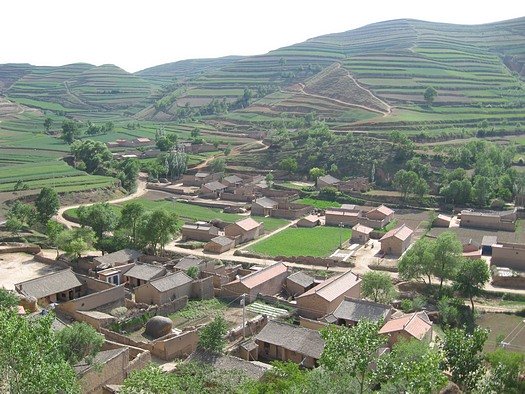
Of course, there are other crops grown in Ningxia. Because of the arid climate, irrigation is used extensively and where there is adequate rainfall, as much land as possible is used for agriculture. In this public domain photo of a village called Zhangyi (pronounced "jang ee") in southern Ningxia you see how hillsides are terraced to provide more growing land.
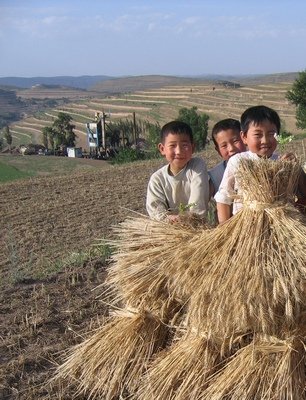
Here are some happy kids out in a field in Penyang county. Notice again the terraced fields in the background.
I find it interesting that in this area where obviously there is a lot of agriculture, the soil still looks pretty dry. Maybe it's just the time of year and it would look much better before harvest. (After all, the picture above does have a lot of greenery.) But in this picture there is not the rich soil that I would expect.
Below you see a class of middle-school students in Haiyuan. In
China, "middle school" is rougly what would be called "high school" in
North America, but often there is a junior middle school for age 12-14
and senior middle school for age 15-18. This is a particularly crowded
classroom. The classrooms I've seen in Chinese schools typically have
about 40 students per class and they have desks.
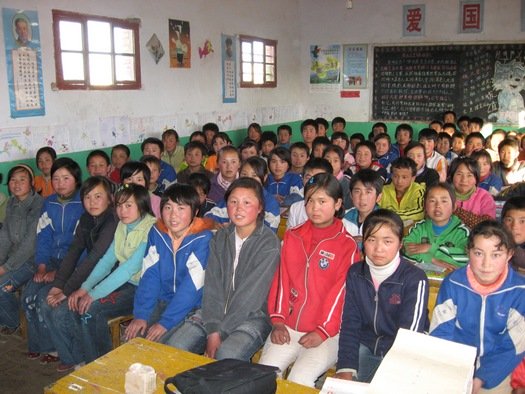
The public domain photograph below shows some students in a primary school in Pengyang. This is a more typical classroom setting, with two students per desk. Notice the red scarves and the school uniforms.
In the Chinese cities I've lived in, it is normal for all students to wear a school uniform, a sort of sweatsuit, and most that I've seen have been blue as you see in these photos. Obviously this is not a requirement in the schools represented here, and I'd guess that's because some students are unable to afford the uniform.
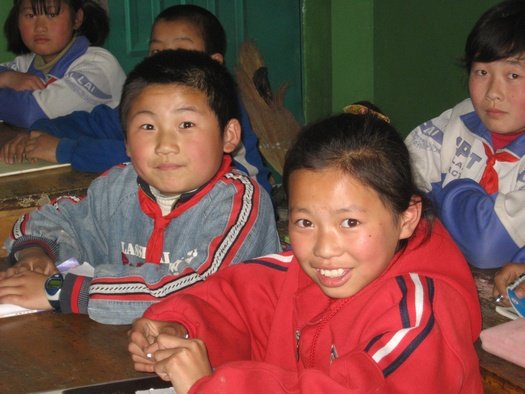
The government in Ningxia is making great efforts to expand education, industry, and agriculture in this traditionally difficult area, but it is an uphill battle. I hope that as Chinese domestic tourism increases many more tourists will go to Ningxia and that that will build the international tourist trade too. As a significant hub on the old silk road between Asia and Europe, this area has much of cultural and historical interest.
Let me end this page by reminding you that the most interesting thing about the Ningxia Hui Autonomous Region is the Hui people. Islamic tradition and practices are a vital part of this culture. A Japanese-American friend of mine who taught many years at Ningxia University would never allow pork in his kitchen so that his Hui students would feel free to eat with them - it is that important.
Discover not-so-famous places that international tourists are missing on this page about tourist sites in Ningxia. To see some artifacts and for information about the Ningxia silk road, click here.